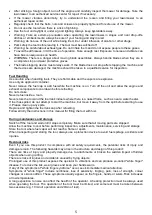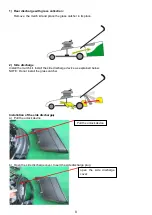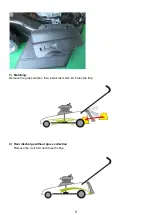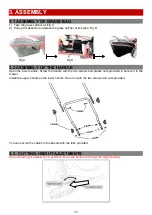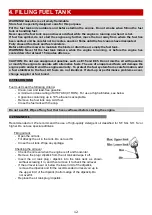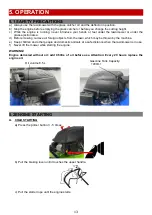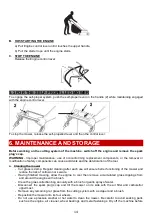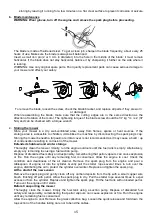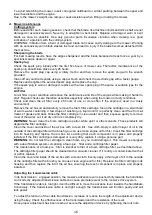
To avoid scratching the mower, insert corrugated cardboard or similar padding between the upper and
lower handlebars and the engine.
Due to the mower’s weight, use ramps or seek assistance when lifting or loading the mower.
d. Mower maintenance
Cutting system
Before and after each mowing session, check that the blade, its attachment bolts and drive shaft are not
damaged or excessively worn. Never try to straighten a bent blade. Replace a damaged, worn or bent
blade as soon as possible. Use only genuine parts. Excessive vibration when mowing is a good
indication of a problem with the cutting system.
WARNING: Vibration from a bent or damaged blade can cause costly damage to the mower. Working
with an excessively worn blade wastes fuel and can lead to injury if the blade becomes detached from
the machine.
Sharpening the blade
For best mowing results, have the edges sharpened and the blade balanced at least once a year by a
specialist service dealer or agent.
Spark plug
Check the spark plug initially after the first five hours of mower use. Thereafter, maintenance of the
spark plug should take place every 25 hours.
Remove the spark plug cap using a rotary motion and then remove the spark plug with the wrench
provided.
Clean off any carbon deposits using a copper brush and check the electrode gap with a feeler gauge.
Replace and retighten the serviced spark plug and replace the cap.
If the spark plug is worn or damaged, replace with a new spark plug of the same or suitable type for the
engine.
Air Filter
An air filter in poor condition will reduce
the performance and life of the engine
while making it harder to
start. Regular checks are therefore essential, especially
when using the mower in dusty conditions.
Check and clean the air filter
every 25 hours of use or more often if
the engine is used in a dusty
environment.
Remove the air box lid and carefully remove the foam filter
cartridge. Clean the cartridge in a small bowl
of warm water containing a
few drops of washing up liquid until it is perfectly clean and free from all
traces of grease and dust. Rinse the filter cartridge in clean water and then
squeeze gently to remove
most of the water. Let it air dry until it is
completely dry.
WARNING:
Never clean the foam cartridge in petrol, white spirit or other solvents. These products will
degrade the filter cartridge.
Clean the cover and inside of the air box with a clean lint
‐
free cloth. Apply a uniform layer of oil to the
outside of the cartridge filter with a brush (you can use clean engine oil for this). Insert the filter cartridge
into its housing and replace the air box lid, ensuring that each component is in place and properly
installed. If the filter cartridge is damaged or is very dirty, replace it using a genuine part.
WARNING:
Do not twist the cartridge to clean foam, as you could damage it. This mower is equipped
with a dual filtration system comprising a foam pre
‐
filter and a cartridge filter paper.
The maintenance of a foam pre
‐
filter is identical to that of a foam cartridge filter, as described above.
The cartridge filter paper should be cleaned with a vacuum cleaner. If it is dirty or contaminated with oil
or petrol, replace it.
Clean the cover and inside of the air box with a clean cloth. Evenly apply a thin layer of oil to the outside
of the cartridge filter with a brush (you can use clean engine oil for this). Replace the filter cartridge in its
housing and then replace the lid of the air box, ensuring that each component is in place and properly
installed.
Adjusting the transmission cable
In its transmission
‐
engaged position, the mower’s advance lever is pushed
fully towards the handlebar.
An incorrectly adjusted transmission cable can
cause premature wear to the mower’s drive system.
If the transmission cable is too tight, it will be difficult to move the advance
lever towards the handlebars.
Conversely, if the transmission cable is not tight
enough, the transmission will function poorly and will
lack power.
To adjust the tension of the cable transmission,
increase or reduce the length of the adjustment
device
using the key. Check the effectiveness
of the transmission and the resistance of the lever.
Once proper adjustment has been reached, secure
the adjustment device by tightening the lock nuts.
16




